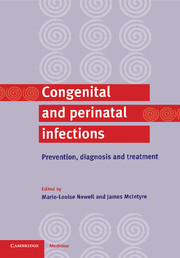Book contents
- Frontmatter
- Contents
- List of contributors
- Preface
- Part I General issues
- Part II Specific infections
- 5 Rubella infection in pregnancy
- 6 Perinatal Group B streptococcal infections
- 7 Mother-to-child transmission of cytomegalovirus
- 8 Varicella
- 9 Herpes simplex
- 10 Vertical transmission of hepatitis viruses
- 11 Papillomavirus infections as a perinatal problem: diagnosis, prevention and management
- 12 HIV-1 infection
- 13 Syphilis: prevention, diagnosis and management during pregnancy and infancy
- 14 The other sexually transmitted diseases
- 15 Toxoplasmosis
- 16 Neonatal sepsis
- Index
12 - HIV-1 infection
Published online by Cambridge University Press: 06 July 2010
- Frontmatter
- Contents
- List of contributors
- Preface
- Part I General issues
- Part II Specific infections
- 5 Rubella infection in pregnancy
- 6 Perinatal Group B streptococcal infections
- 7 Mother-to-child transmission of cytomegalovirus
- 8 Varicella
- 9 Herpes simplex
- 10 Vertical transmission of hepatitis viruses
- 11 Papillomavirus infections as a perinatal problem: diagnosis, prevention and management
- 12 HIV-1 infection
- 13 Syphilis: prevention, diagnosis and management during pregnancy and infancy
- 14 The other sexually transmitted diseases
- 15 Toxoplasmosis
- 16 Neonatal sepsis
- Index
Summary
Introduction
More than 33 million people were living with HIV by the end of 1998. According to UNAIDS estimates, 22.5 million of these were in Africa (67%), and 6.7 million in South and Southeast Asia (20%). Close to six million new infections are occurring each year, with 10% of these in children, the majority as a result of mother-to-child transmission (MTCT) (UNAIDS, 1998). An estimated one and a half to two million HIV-infected women will become pregnant each year, with 1600 children each day infected by mother-to-child transmission.
In Europe, the increase in heterosexually acquired HIV infection in women of childbearing age has been paralleled by increasing numbers of infected children. Antenatal HIV prevalence in Europe is generally below 5 per 1000 deliveries, although variable: higher in selected groups and inner cities. In a number of countries in Africa south-of-the-Sahara, 10–25% of pregnant women are infected, with rates of over 40% reported in parts of Southern Africa (US Bureau of the Census, 1999; Stanecki & Way, 1999). Southeast Asia has seen a rapid rise in infection rates in some areas.
HIV infected children most commonly present early in life with non-specific clinical manifestations. About one-quarter of infected children will develop AIDS in the first year of life, but the progression of disease in the remainder is much slower. In developed countries about 75% of infected children are alive by age 5 years, and in developing countries about 40% (French Pediatric HIV Infection Study Group and European Collaborative Study, 1997). HIV/AIDS has increased infant and child mortality dramatically in the most affected African countries, and is expected to lead to a doubling of under-5 mortality by 2010 in southern African countries.
- Type
- Chapter
- Information
- Congenital and Perinatal InfectionsPrevention, Diagnosis and Treatment, pp. 232 - 257Publisher: Cambridge University PressPrint publication year: 2000

